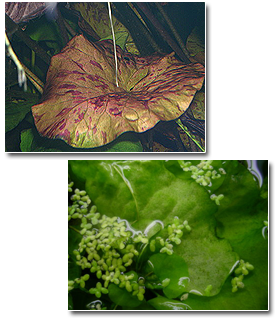Lighting
Lighting for an aquarium can be almost as variable as the filtration. As a general rule, non-photosynthetic organisms (most animals and bacteria) do not require very much light, but seem to do best with some sort of distinct day/night cycle. Photosynthetic organisms (plants, algae, and many corals) require sufficient light to thrive. How much light is considered sufficient really varies from species to species and even between individuals of the same species in cases when they may be collected from different environments.
A tank with non-photosynthetic organisms (fish only, ahermatypic corals, sponges, worms, mollusks) can get by with minimal lighting; usually simple incandescent or single fluorescent lights. Brighter systems can be used but are not necessary. If you plan on keeping animals that are nocturnal or come from deeper marine environments then the animals will be more active in a lower light level.
A tank with photosynthetic organisms is going to require enough light of the appropriate spectrum to so that they can perform photosynthesis. Most aquarists look at their lighting system in terms of watts per gallon, which is not a very good measurement unit since the amount of light actually produced can vary depending on the efficiency of a particular light source. Systems like LEDs are the most efficient at converting electrical energy (watts) into light (lumens or lux). Fluorescent systems like T-5 high output (HO) are very efficient followed by power compact, standard output, and very high output (VHO). Incandescent systems are the least efficient but can be extremely bright and hot (metal halides or halogen). Since all lighting systems come with a wattage rating and most people do not have the equipment to measure light intensity talking about watts per gallon has become the industry standard, but each aquarist should consider the efficiency of their own system.
The following intensity levels refer to power compact or standard output fluorescent systems. In a planted freshwater system, <1 watt per gallon is generally considered low light, 1-2 watts per gallon is moderate light, and 3+ watts per gallon is high light. In a saltwater tank with hermatypic corals and algae, <3 watts per gallon is generally considered low light, 3-5 watts per gallon is moderate, and 5+ watts per gallon is high light.
In some cases aquarists will keep smaller much less intense lights (usually blue or red) on a high light system at night to mimic moonlight, gradually transition between light and dark, or simply to see nocturnal animals.
In terms of the spectrum (color) of light used on a system, there are also many possibilities. For the most part, non-photosynthetic are not too picky about what color light they are exposed to. For the plants and hermatypic corals a full spectrum light source is usually the best option. Most full spectrum bulbs come with a Kelvin (K) rating that indicates the overall color of the light produced (6700K is a bit yellow while 10,000-20,000K is more blue). When it is possible to mix bulbs of different colors in one system you can see better color rendition in the tank. Using color enhancing (pink) or actinic 03 (blue) bulbs can work well in most systems.

